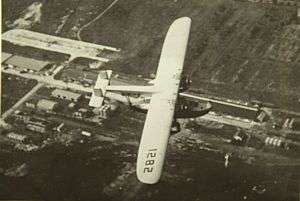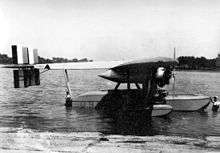Sikorsky S-36
| Sikorsky S-36 | |
|---|---|
 | |
| Role | Eight-seat amphibian |
| National origin | United States |
| Manufacturer | Sikorsky Aircraft |
| First flight | 1927 |
| Introduction | 1927 |
| Primary user | Pan American Airways |
| Number built | 6 |
| Developed from | Sikorsky S-34 |
| Developed into | Sikorsky S-38 |
The Sikorsky S-36 was an eight-seat amphibian sesquiplane designed and built by the Sikorsky Manufacturing Company in the late 1920s. The aircraft was ordered by Pan American Airways, the start of a long association with Sikorsky flying boats.[1]
Development
The S-36 was a modified and larger version of the earlier S-34 and was designed as a commercial aircraft for six passengers or freight. It was an amphibian sesquiplane with a boat hull fuselage and retractable landing gear. It was powered by two Wright Whirlwind J-5 engines and had a crew of two and room for six passengers on two facing bench seats. Only six aircraft were built.
Operational history
One aircraft named Dawn was sold to Mrs Frances Grayson for an attempt to be the first woman to fly across the Atlantic. As a passenger in Dawn and after two false starts the aircraft departed for the Atlantic attempt on 23 December 1927 but was not seen again.[1]
The United States Navy bought one aircraft, designated the XPS-1, for evaluation as a patrol aircraft, it was fitted with a gunner's position in the bow although it was used as a transport.[1]
The fourth aircraft was delivered to Pan American Airways in December 1927.[1]
Accidents and incidents
A wealthy divorcee, Mrs. Francis Grayson, Brice Herbert Goldsborough (navigator), Oskar Omdal, and Fred Koehler (passenger) set off to cross the Atlantic (a 3rd attempt) on Dec 23, 1927 in a Sikorsky S-36 named "The Dawn".[2] Sea conditions were stormy and rough, but she was she was determined to be the first woman to fly the Atlantic. They passed Cape Cod at 8 AM, headed for Harbour Grace, Newfoundland. The Sable Island wireless station picked up "Something's wrong here" with their call letters...30 miles distant. They did not reach a landing port. This caused the first ever air relief expedition, including 2 destroyers and the USS Los Angeles dirigible. A message in a bottle was found on Jan 29, 1929; it read "1928, we are freezing. Gas leaked out. We are drifting off Grand Banks. Grayson." Nothing more is known.[3]
Variants

- S-36
- Production aircraft, five built.
- S-36B
- Evaluation aircraft with Wright J-5 engines for the United States Navy as the XPS-1, one built.
- XPS-1
- One S-36B for evaluation by the United States Navy
Operators
Specifications (S-36 production version)
Data from [4]
General characteristics
- Crew: 2
- Capacity: Six passengers
- Length: 34 ft 0 in (10.36 m)
- Wingspan: 62 ft 0 in (18.9 m)
- Height: 12 ft 0 in (3.66 m)
- Wing area: 585 ft2 (54.35 m2)
- Empty weight: 3950 lb (1792 kg)
- Gross weight: 6000 lb (2722 kg)
- Powerplant: 2 × Wright Whirlwind radial engine, 200 hp (149 kW) each
Performance
- Maximum speed: 120 mph (193 km/h)
- Service ceiling: 15,000 ft (4572 m)
- Rate of climb: 600 ft/min (3.05 m/s)
See also
- Related lists
References
- Notes
- Bibliography
- Best, Martin (2003). "Sikorsky American Fixed-Wing Aircraft, Part 2: Sikorsky S-36 to S-38". Air-Britain Archive. 2003 (1): 31. ISSN 0262-4923.
- The Illustrated Encyclopedia of Aircraft (Part Work 1982-1985). Orbis Publishing.
- "The Sikorsky S.36.B Amphibian: An Interesting Flying-Boat of Unusual Design". Flight. XIX (42): 738–739. October 20, 1927. Retrieved October 11, 2012. A contemporary technical article on the S-36.
External links
| Wikimedia Commons has media related to Sikorsky S-36. |